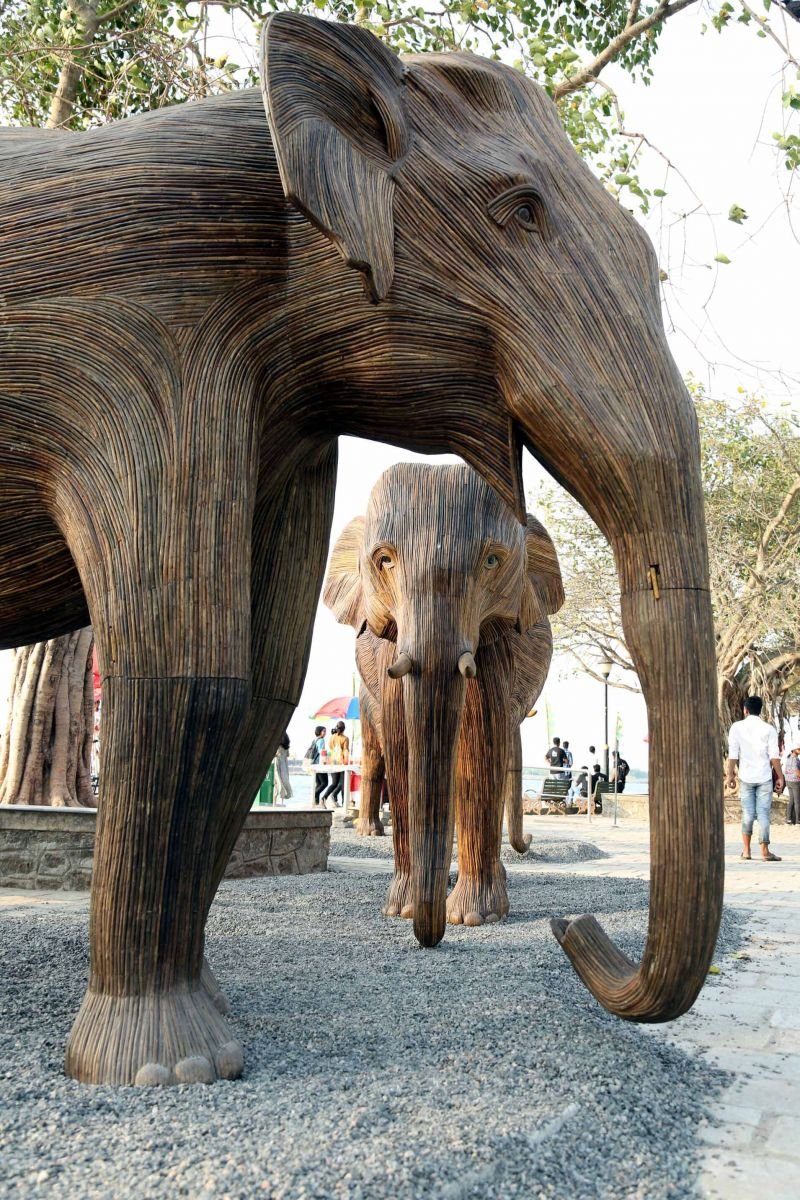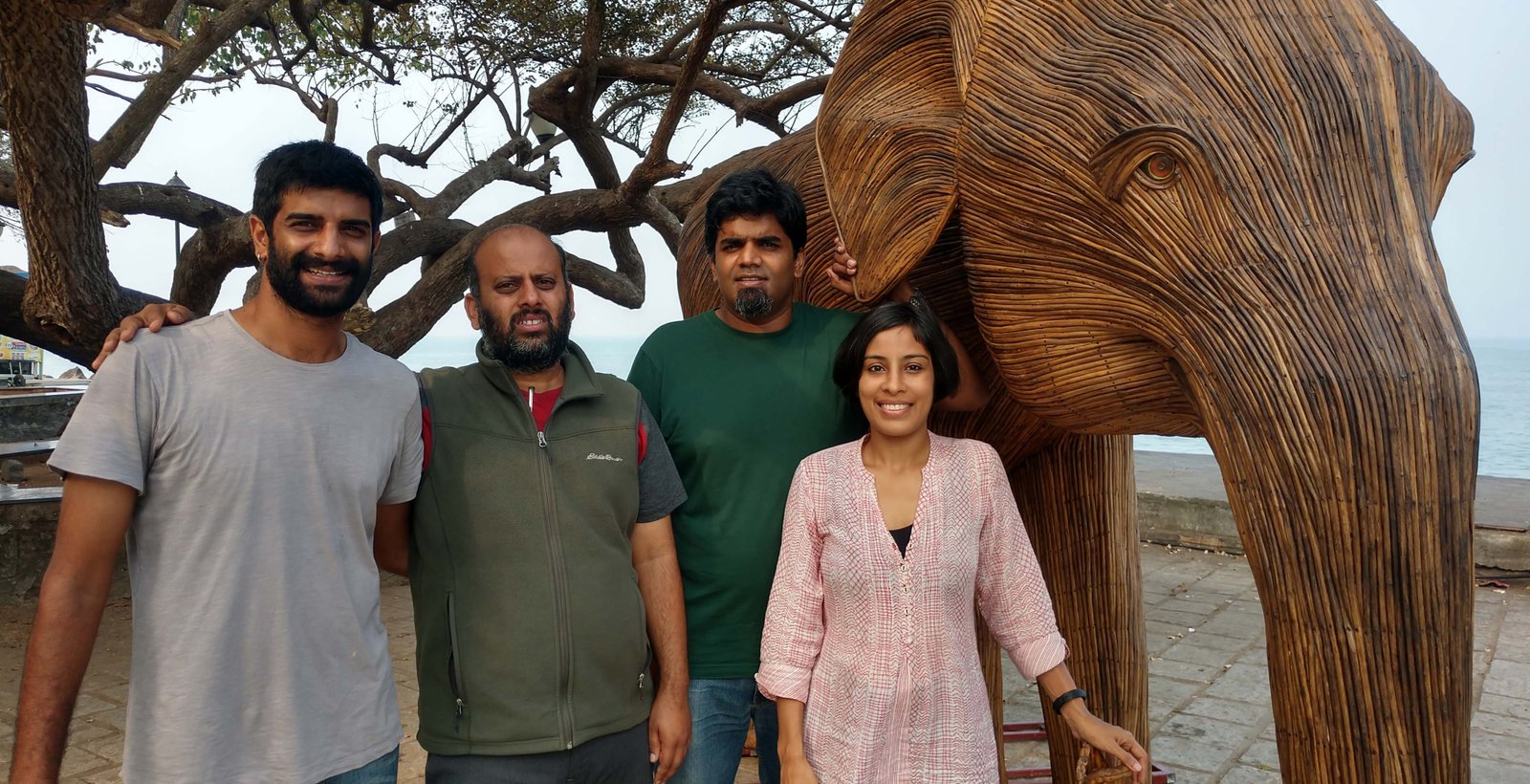The Travelling Band of Elephants
Text: Priya S
The overall objective of the project travelling the globe and a public exhibition is to change the way people think about conservation The biggest advantage of this unique project is that the toxic Lantana weed is being cleared from the Nilgiri forests.
Regulars strolling along the Fort Kochi beach are used to the sight of trotting horses and camels carrying squealing riders on their backs, held in check by their handlers running alongside them. But the sight that beheld beachgoers left many wonderstruck and speechless- for standing on the beach, in all their brown skinned glory, were a herd of 30 elephants ranging in size from three and a half feet to ten and a half feet in height. Joining the group who were closely inspecting the elephants, Priya S realised that the herd had been sculpted with a great eye for detail, evident in their life-like appearances.
Considering the increasing man- animal conflicts and the diminishing numbers of Asian elephants in the wild, this unique project seeks to highlight the threats faced by these magnificent pachyderms, not only due to human intervention but also because of their habitat invasion by harmful lantana weed forcing the animals to move out of their habitats to forage for food.

The congregation, comprising of adults and calves, are the magnificent creation of a group of tribal artisans from Thorapalli in Gudalur using Lantana camara or Lantana, a toxic invasive weed and is part of an exhibition titled CoExist- Matriarchs for a Whole Earth.
A 100 of these life-size lantana elephants will prepare to set sail across continents to London’s Royal Parks and across the Atlantic to the US in 2020. Each elephant model is based on a real wild elephant in the Nilgiris, created by a team of 70 tribal artisans, to be auctioned in the UK and United States with proceeds going to the Fund to raise funds for their conservation. The collaborators of the project include the UK based Elephant Family, The Real Elephant Collective (TREC), the Ashoka Trust for Research in Ecology and Environment (ATREE) and The Shola Trust.
Considering the increasing man- animal conflicts and the diminishing numbers of Asian elephants in the wild, this unique project seeks to highlight the threats faced by these magnificent pachyderms, not only due to human intervention but also because of their habitat invasion by harmful lantana weed forcing the animals to move out of their habitats to forage for food.
Ruth Ganesh, Principal Trustee of the U K based Elephant Family conceptualized the Lantana herd along with Shubhra Nayar and Tariq T of TREC with Subhash Gautam overseeing the production process. Tarsh Thekaekara, a conservationist from the Shola Trust who studies elephants, explains the initial plans ,”We (includes the tribal community) had been thinking of making furniture out of lantana vines but the tribals hardly ever use furniture so that was not exciting enough,” he explains.
Incidentally Shubhra, Tarsh’s wife and a designer by profession, paved the way for the elephant modeling and designing. “My husband Tarsh and I have collaborated in the past on my work with life-size puppetry. He has an incredible skill with converting my large drawings and mockup clay sculptures to reality in metal framework. This came in handy when we worked together to figure out the inner structures of the lantana elephants. The first few were made by both of us in our back garden,” begins Shubhra.
She has always drawn and sketched in large format, on reels of paper rather than sheets. Over the last 8 years she has been sketching elephants from Tarsh’s field research, using them as study subjects. So when the idea was hatched between Tarsh and Ruth, it seemed natural that Shubhra step in to realise the forms of these elephants.
The first forms were drawn to scaleelephant size! She recalls, “I stood with charcoal taped to the end of a long wooden pole and drew the elephant at life-size on sheets of paper stuck together for a surface. We have a mezzanine in our home, I would go up there to gain enough distance for viewing and checking the proportions. This was then used by Tarsh and the welders to create the first elephant structures.”
Many edits later, especially those hand done by Tarsh for the face and head of the elephant, the process became quite streamlined. She informs, “I work at a smaller scale for the profile sketches of each elephant. Ranjini, who is Bettakurumba with a double Masters and a keen eye for detail, draws them into plans that can be followed by the welders and the lantana craftsmen.”
With Shubhra’s background in design for performance, this work combined her experience with set design and life-size puppetry perfectly. “I would of course have liked to create movement in the elephants, even small subtle ones to surprise a viewer, or add sound bites to the installation to make it more interactive, but that’s my performance side speaking - and perhaps some of these ideas will find their way to future displays of the herd!” she hopes.
“Each of these elephants has a unique story and these animals have learnt to co –exist alongside humans in the wild,” Tarsh informs.

The first prototype of the elephant sculpture was made in 2015 with its own share of gargantuan challenges. “Each elephant takes a team of 6 artisans, sixeight weeks to sculpt, depending on the size with some elephants even weighing 300 kilograms,” Tarsh says. The 70 tribal artisans from indigenous communities in Gudalur were involved in sculpting each elephant in two workshops, providing them a source of livelihood.
Tarsh states that the overall objective of the project travelling the globe and a public exhibition is to change the way people think about conservation,”Conservation is thought of as saving some animals in a far off place. That’s not it. We are fast destroying the forest cover in India. Yes, there will be protected areas for animals and there will always be cities coming up with human habitations and the key is to build and co –exist with nature. The exhibition is all about co-existence,” he explains. He mentions that the lantana weed also poses a big problem to not only India but also the world and putting the weed to such use also helps in generating income to the communities. The biggest advantage of this unique project is that the toxic Lantana weed is being cleared from the Nilgiri forests. ATREE provides the lantana for the sculptures.
The organizers hope that the profits generated would work towards the goal of raising five million dollars for the Asian Elephant Fund, to be used for the conservation of Asian elephants in thirteen countries.
My husband Tarsh and I have collaborated in the past on my work with life-size puppetry. He has an incredible skill with converting my large drawings and mockup clay sculptures to reality in metal framework .




